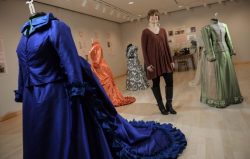
She’s known as the Merry Dressmaker.
Wright State University graduate student Angela Reichelderfer has designed and sewn seven historical dresses as part of her master’s thesis project and art exhibit.
It’s a dazzling display of fabrics, frills, flounces and ruffles — ranging from an electric blue gown with a butterfly train from the Early Bustle Era to a tangerine-colored dress from the Natural Form Age.
The exhibit, which looks like a high fashion show frozen in time, is on display at the Robert and Elaine Stein Galleries in Wright State’s Creative Arts Center through Feb. 17. It is free and open to the public.
Reichelderfer produced the seven dresses in only two months, using a modest Viking sewing machine and mostly her fingers.
“There was a lot of hand sewing,” she said. “I have what we call needle callouses, where you don’t even need the thimble anymore.”
Marjorie McLellan, associate professor of urban affairs and geography, said Reichelderfer completed her thesis — with work, family and her inquisitiveness adding to the challenge.
“She has done historical clothing design in the past and so the exhibit brings two threads — research and craftsmanship — together beautifully,” said McLellan.
Reichelderfer grew up in Columbus, graduating from West High School. She later attended Otterbein College, where she earned a bachelor’s degree in journalism, and went on to teach English as a substitute teacher in Dayton.
She got into dressmaking by accident when she made a black wool, flannel-lined coat for her mother as a Christmas gift. Suddenly, her friends and other family members wanted outfits too.
In 1999 and for the next decade, Reichelderfer sold her cloaks at the Ohio Renaissance Festival, the site of a fictional 16th century English village in Warren County, with 12 outdoor stages and more than 100 shops.
“I was also making my own costumes because you are required to dress the part while you’re there,” she said. “And then I had other merchants and vendors ask me to start making their clothing.”
Reichelderfer enrolled at Wright State to earn her master’s degree in order to continue teaching. She is in the Master of Humanities, with an emphasis on history, and is scheduled to graduate in the spring.
Reichelderfer has always been interested in the women’s clothing industry, particularly in the Progressive Era of 1880 to 1920. So she made the subject her master’s thesis.
She said dressmakers of that era were not garment workers sitting at sewing machines in factories.
“These were highly skilled educated women,” she said. “It took them anywhere from seven to 12 years of apprenticeship to learn to make dresses.”

Angela Reichelderfer produced the seven dresses in the exhibit in only two months, using a modest Viking sewing machine and mostly her fingers.
The dressmakers were creators, designing everything from start to finish, she said. Every gown was unique in size, dimension and fabric.
“Dressmakers were highly respected; their profession was taken very seriously,” she said. “For women, it was the only respectable profession where a woman could truly have financial independence and not choose to be married if she didn’t want to. She had an alternative to that type of lifestyle.”
The dressmakers, more than 99 percent of whom were women, largely did not take part in the women’s suffrage movement because they monopolized the dressmaking industry and saw change as a threat to their economic viability.
Reichelderfer’s thesis, titled the “Fall of the American Dressmaker 1880-1920,” chronicles the Progressive Era and its end. It also touches on the advent of simpler, less restrictive women’s clothing.
The Industrial Age served as a two-edged sword for women’s fashion. During the Progressive Era, it enabled the industrial rich to show lavishness in their clothing as a symbol of their wealth. But it also gave rise to mass production, which rode the wave of growing interest in less formal, more comfortable clothing.
“When World War I comes around, it’s the nail in the coffin because women can’t wear their traditional clothing,” said Reichelderfer. “They wouldn’t survive in a factory.”
French fashion designer Coco Chanel was credited in the post-World War I era with liberating women from the constraints of the corset and popularizing a sporty, casual chic as the feminine standard of style.
Reichelderfer designed her exhibit to engage visitors and give them a real experience. The dresses are artfully displayed on mannequins and strategically located for optimum viewing. The history of each dress and its era is spelled out on placards that hang on the walls.
Visitors can pick up nuggets like this: “In 1917, the United States War Board asked women to stop buying corsets to conserve steel for the war effort.”
The exhibit also pays tribute to Wilberforce University, which trained dressmakers. More than 600 women took the school’s dressmaking courses.
“I want people to be able to weave in and out and have a 360-degree view of all of these gowns,” said Reichelderfer. “I want them to get close up and actually look. And I want them to think about it after they leave.”

